Pebble smartwatch: how to become a rarity overnight
The very first modification of Pebble watches went on sale in January 2013. In December 2016, it became known that the company ceases to exist, and it was unexpected: a seemingly successful round of the KickStarter fundraising for the third generation of smart watches was just happening - and you.
In the spring of 2018, under rather strange life circumstances, I lost my Pebble Time Steel watch. So I lost that I cannot even name a specific date, that I had them, but not. As if, together with pants, a smartphone and headphones, I moved to another dimension, and the clock remained somewhere where there are walls at home, memories, youth in the end, but I no longer exist.

Stosh , I thought, is even more interesting. In fact, Pebble with its unexpected failure gave me a unique chance to replenish my collection of outdated devices at the moment when these outdated devices can still be obtained with new ones in the package . At the same time, it became possible to compare PDA devices like Palm and modern, tied to a cloud so that without it they almost do not work. And you know, not everything is so bad! Pebble, it seems, will live for a long time thanks to the community of caring users and developers.

It is very easy to document the history of Pebble watches; they are not laptops of the mid-1990s. Even here, on Habré, you can find a complete retrospective. Here is a note about the very first fundraiser on KickStarter, the most successful in history (at that time). Almost 69 thousand backers, more than 10 million dollars have been collected, the page on the crowdfunding platform is still alive . In March 2013, the first review of the clock , still in the original iteration, with a non-separable case. There is still no support for Russian letters, it will be first cut with a special version of the firmware, then it will be possible to choose Cyrillic support directly in the application. An in-case package makes it unlikely to fix a mass bug with a striped display. And here is the first post about programming. But the second .
')
The Pebble company was conceived, founded, dispersed to the first space and sent to a different world by Eric Migikovsky. The formation of the company took place against the backdrop of constant rumors that the smart watch is about to launch, literally the next day, Apple. In those years, I didn’t have the feeling that it was such a marketing conspiracy of Apple: to launch rumors so that competitors would spend, spend, spend money on R & D, and then save. The first Apple watch was introduced in September 2014. In March of the same year, not the most, as it has now become clear, successful Android Wear platform was introduced. All this was accompanied by the release of watches that looked more like prototypes, cost horse money and worked on a half-day battery, if they were not watched, if possible.
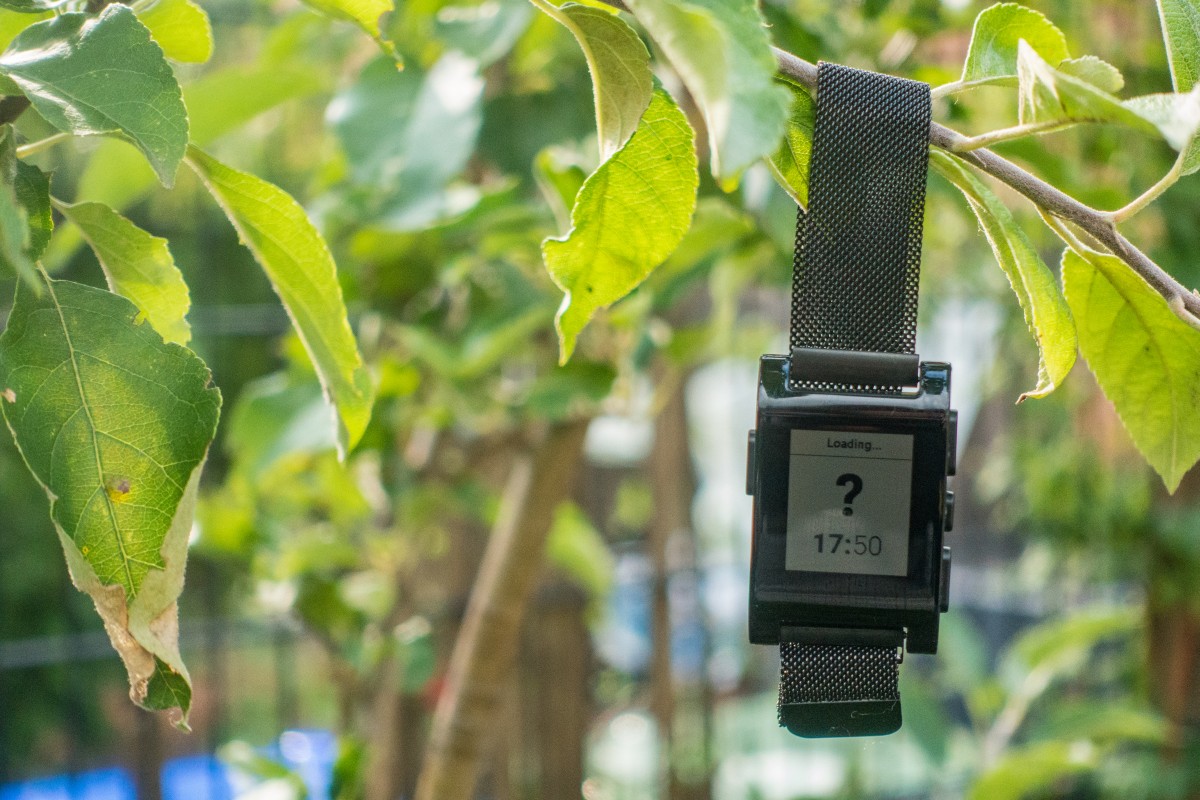
Or so I remember, I will not pretend to the accuracy of analytics. For me, as a consumer, Pebble had some kind of iron logic: they are relatively inexpensive, they work on batteries for several days, buzz with notifications, and expand with third-party applications. Beauty! Probably the same criteria guided another million people around the world. So many copies of the first generation Pebble Watch were sold by the end of 2014. This includes both the very first plastic watches and the brutal-square Pebble Steel, first shown at the beginning of 2014. And in February 2014, MadRobots company in its blog on Habré wonders : why do we need smart watches? Almost the whole of humanity is ascribed to the same question with the exception of that million (well, a little more) fans. In 2017, according to IDC , 37.9 million smart watches were sold . Compared to a half billion (!) Smartphones, this is quite a bit.
It seems to me that the initial prerequisites of those responsible for the production of devices are visible in the final product. If you have the task of “staking the market”, “not losing sight of new promising areas,” then you will end up with something strange, which has to change the operating system with a regular software update. Pebble - it was a geek company that created devices in accordance with its very clear understanding of what a geek device should be: extensibility, cloud SDK and the like.
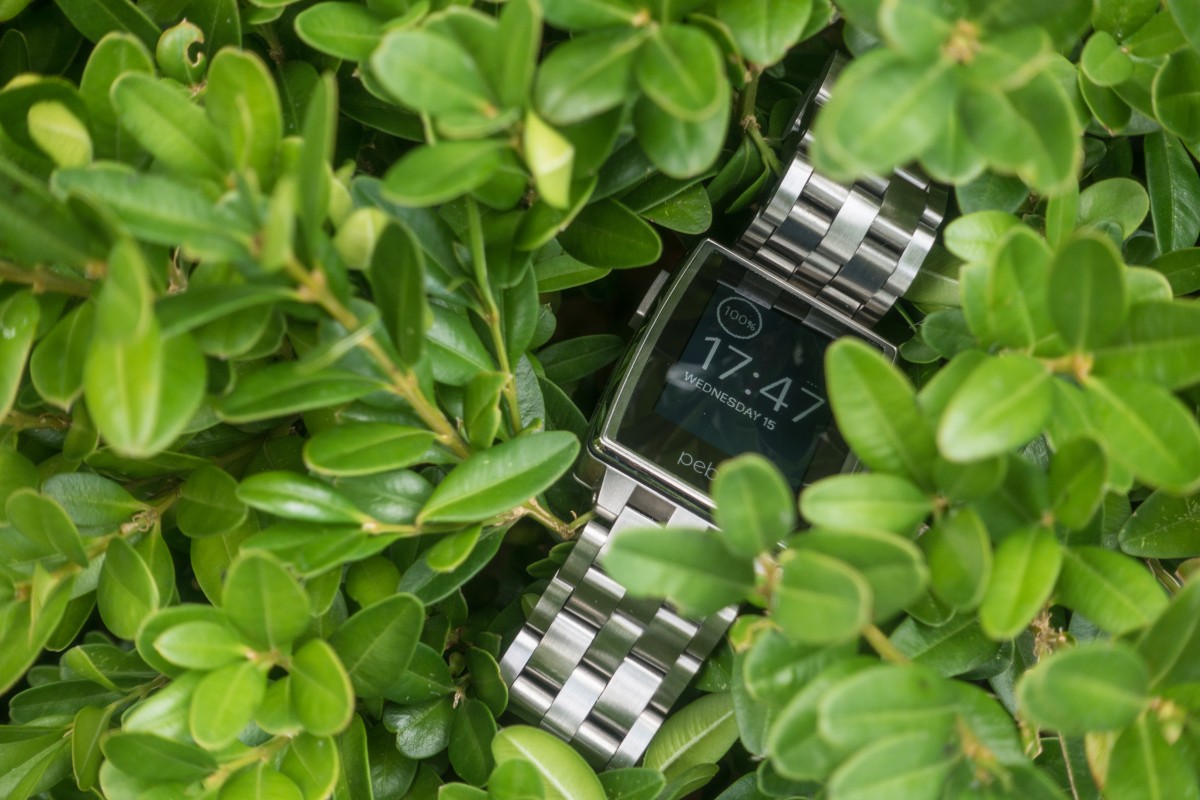
However, I digress. Here's a nice post with live coverage from the Pebble office from mid-2014. Here to the clock (figuratively) screw the light bulb . Here is an example of the manufacture of the dial (in terms of Pebble - watchface). And here is January 2015: Pebble announces Pebble Time. Immediately declared the normal version and the "steel" more expensive; collected 20 million dollars, twice as much, from 78.5 thousand backers, 7% more than in 2013. The two main pieces: as if a little color screen and a built-in fitness application: monitors the activity (step, run, training) and sleep (the balalaika about Pebble fitness and its flaws in my telegram ). During the campaign, Eric Migikovski answers the question about the threat from Apple Watch: on the contrary, they will attract the attention of a new audience. February 2015, on Habré post about the promotion of the application in the app Pebble. Service at Pebble is just awesome. That same problem with a stripping screen is usually solved by sending a new device towards the client, without the requirement of returning the old one. But you can disassemble, and stick the tape . Developers and even give out hours for free .
In the summer of 2015, I buy Pebble Time Steel. The previous watch is the original Pebble, I tried to repair it with electrical tape , but in the process I broke out the plastic sockets of the screws, the watch worked, but it looked ugly. I cease to be interested in company news for a while: I am already doing well, why? An elegant Pebble Time Round passes by me, which for the sake of design and thickness has reduced the battery to two days of battery life. In May 2016, I fully approve of the new campaign on KickStarter: Pebble 2, Pebble Time 2 and Pebble Core smart keychain are collecting funds for it. And in December 2016, the shop suddenly closes: Pebble is sold to FitBit, only intellectual property is bought, there will be no new watches, there will be no support for the old ones, nothing will be. Infrastructure support is promised throughout the year .
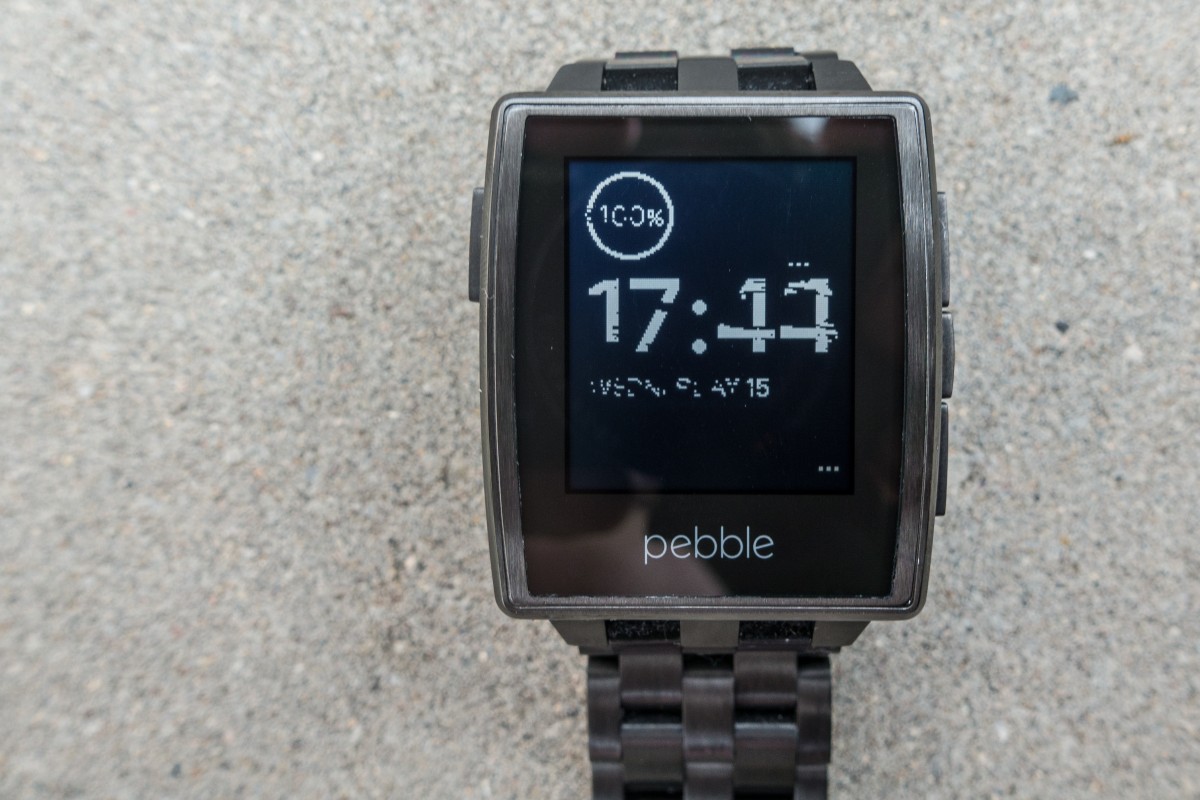
How so? Article in the journal Wired partially reveals the details of the secret contract for the sale. Pebble experienced financial difficulties in early 2016. At the same time, problems with attracting investments became obvious: attractiveness seems to have lost both Pebble itself and the market of smart watches in general. Everyone expected rapid growth, which did not happen. The exit from Pebble 2 to KickStarter was a forced step, and it was, in relation to expenses, a failure: the amount of fees was slightly higher, and the number of supporters was slightly lower than in the very first campaign of 2013. The company developed in accordance with the expectation of growth, which did not happen. While management was thinking about the next steps, the situation became critical. Selling the company's assets in favor of FitBit - apparently this was the best decision of the worst, when the choice was between such an inglorious end of the Pebble story and a default on obligations. And so it ended decently: both in relation to investors in the last round of crowdfunding (money was returned), and in relation to employees (either employed in FitBit, or they parted in an amicable way). Could it be different? I will write about this at the end of the post, and now personal impressions.

In July 2018, I buy a new Pebble watch on Amazon. There is nothing unusual in this, well, the stocks have not yet been sold out, because even two years have not passed since the closure of the business. But for me, it’s all the same how to go to Eldorado and buy a 1989 Sony Walkman cassette. I - a collector of devices that are outdated for a very long time - ten years ago, if not all twenty. With the exception of the timing, Pebble fully meet all the criteria for vintage. These are (1) interesting devices that (2) are no longer produced, (3) their supply is limited, but at the same time (4) they are in demand. Usually devices after the end of their commercial life go through such stages as “last year’s model with a discount”, “no one needs outdated garbage”, “an expensive prestigious collectible thing”. It seems the second stage Pebble watch will be missed: market analysis has shown that the original Pebble can really be found new inexpensively, but the Pebble Time Steel beu is sold at almost the same price as the new ones. A new for sale more expensive than two years ago! The newest Pebble 2 is sold at the originally planned retail price, despite the lack of support and prospects.

It is interesting, which of the current devices now makes sense to hide the new in the packaging for ten years, then to sell with an incredible profit? Enivey, I, as a fake collector, unmercifully opened the factory seals on the Pebble watch boxes, and got so carried away that at some point I had to stop myself. What do I like about this watch?

Most importantly: they allow you to turn off absolutely all sounds on the phone. When I was left without a watch, it turned out that it was to this feature that I was used to, and I feel uncomfortable without it. I missed important messages, and left the phone with sound on the desktop. But this feature is not unique, it generally provides any smart watch. Another thing is that I got used to Pebble: both to how they adjust the period of silence at night, and to the simple interface of choice - which applications are allowed to hum.

I do not use many applications. The most commonly used is the Music Boss, which allows you to control the playback of music. Unlike regular functionality, there is an opportunity to manage several applications at once. You can pause the music on Google Play and switch to the PowerAMP player - without getting the phone. The second application is Sleep as Android sleep tracker. I use it at five percent opportunity: as an alarm clock. Useful tips on good applications are welcome in the comments.
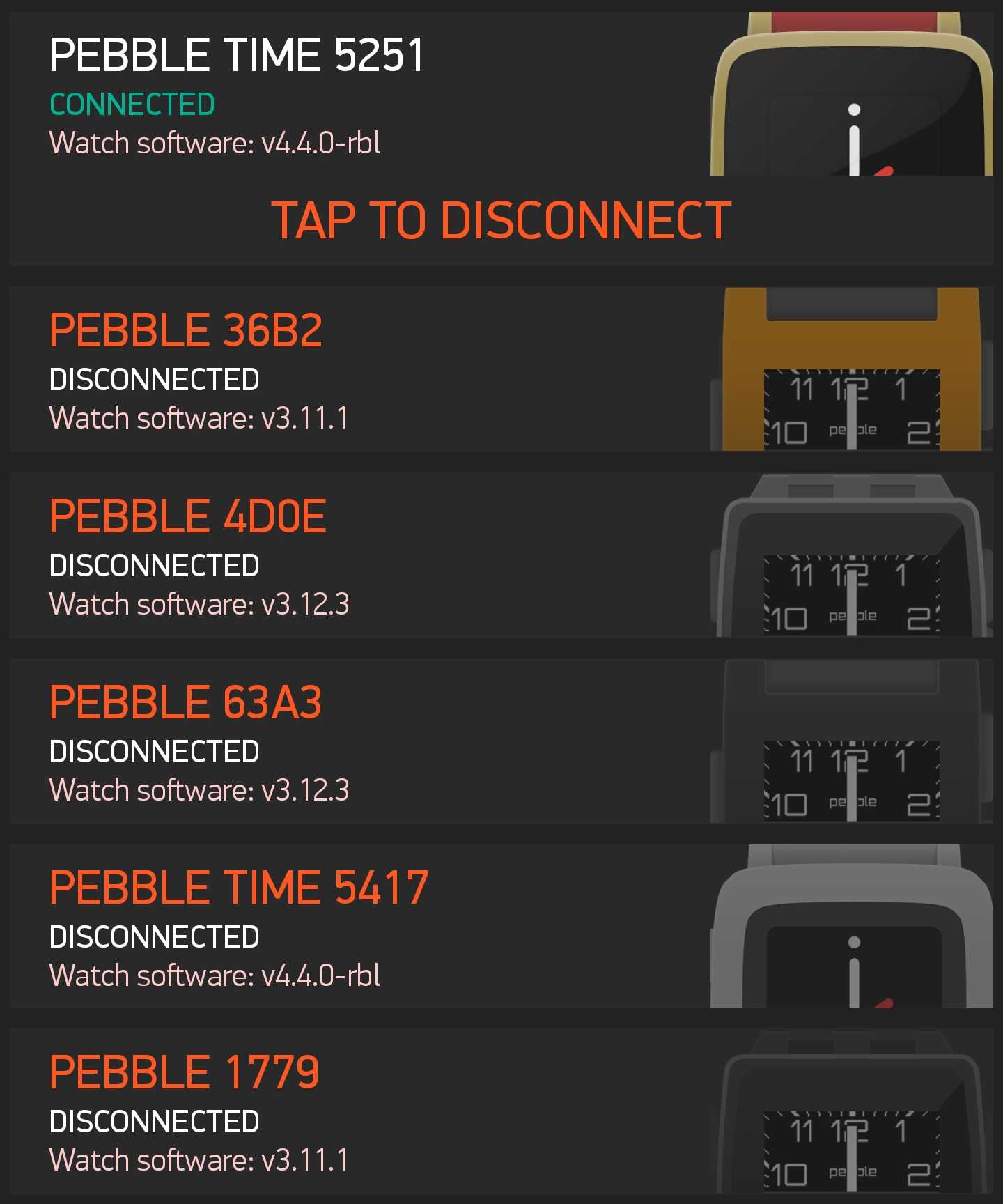
But in my morning ritual now the item “choose a clock” has been added, like that of an aristocrat’s labor (if not counting the penny price of most copies). The Pebble application is well sharpened by switching between the clocks. Just switch, no need to reinstall applications. True, some settings, such as turning off notifications at night, programming buttons for quick launch of applications, are made only on the clock. It seems the settings of the dials are saved separately for the original Pebble and Pebble Time - you have to open the settings one more time in the application on the phone and re-save.
The FitBit company promised to maintain the Pebble infrastructure for a year, and in the end did not shut down the servers for more than a year and a half. Finally, the shutdown of the servers was scheduled for June 30, 2018. The first hours came to me in the tenth of July, but it turned out that it still works: I could install the application on a new phone without any problems, download applications from the Pebble app store and so on.
Actually, the shutdown took place on July 20, and thanks to my new hobby, I watched it almost in real time. A strange feeling: I just searched the Pebble forums for tips on what to do with a non-working watch, but nothing opens, and only the Google cache saves (for a short time).
However, the Pebble watch is lucky, they have a grateful community with hands from the right place. Firstly, Pebble / FitBit released the “final” version of the smartphone app, decoupling most of the functions from having to communicate with Pebble servers. Otherwise, it would not even be possible to start the clock freshly bought or reset to factory settings. Secondly, a group of concerned citizens washed down a cloud infrastructure infrastructure, calling it Rebble .

The Pebble application has the ability to “switch” to alternative service servers. As a result, even after turning off the Pebble servers, for example, the application store and dials are preserved. For an additional $ 33 a year, Pebble Time owners (but not the original Pebble) can continue to receive weather in the timeline and use voice dictation. These are features I don’t need, but I paid for the subscription just to support the project.
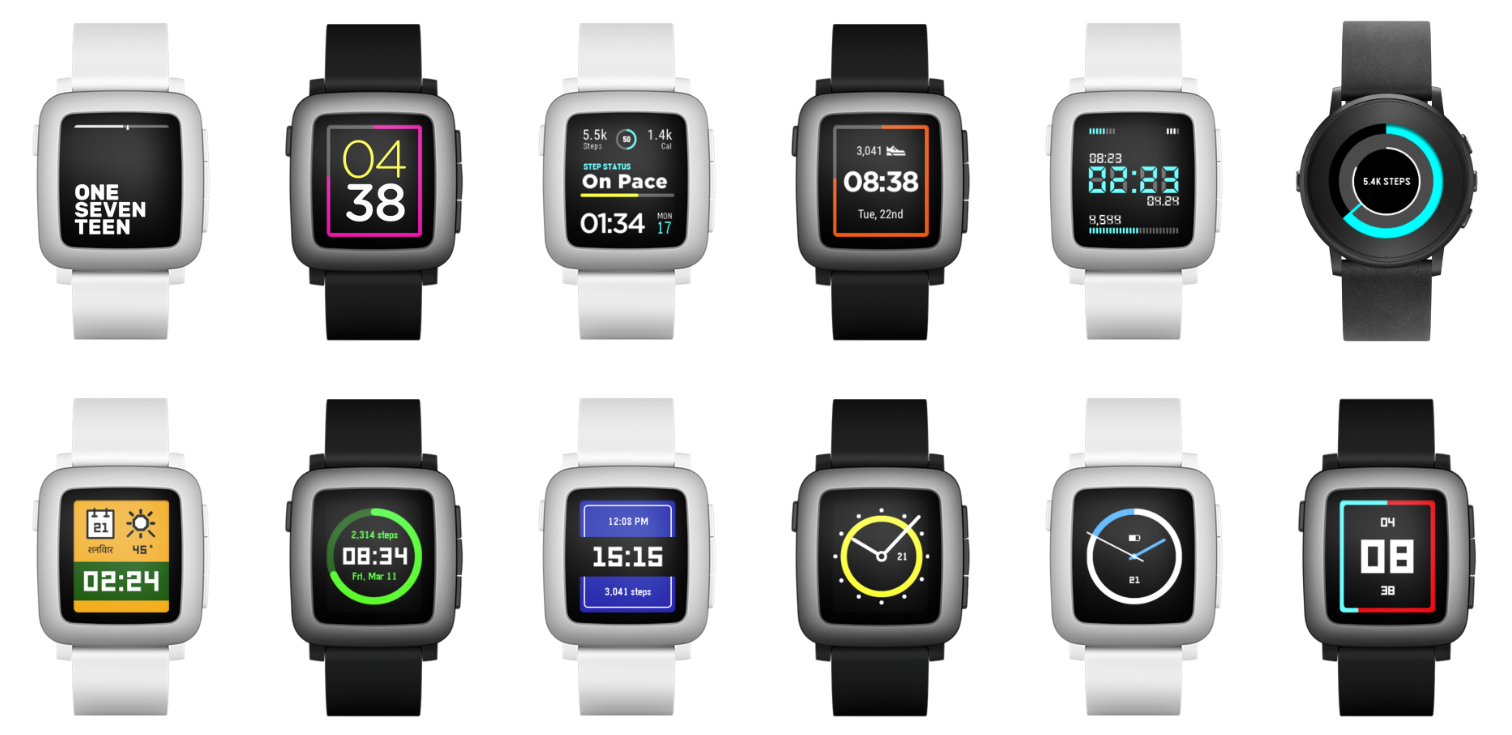
If you suddenly decide to buy a face for money, you still have such an opportunity. For example, a collection of paid hours (a dollar thing or six bucks for everything) is here .
And here Rebble is the coolest part of the Pebble watch story. Unlike the mass of other, sunk into oblivion with the entire infrastructure of devices, Pebble will (for the time being) live because people need them. Not millions, but about five hundred fans all over the world. Perhaps if Pebble as a company initially focused specifically on fans, it would still be alive. Or maybe we got Pebble due to the fact that their creator took a risk and invested in the project more money than he deserved.
Anyway, with the cheapening of both hardware and server infrastructure, there are more chances for the emergence of such niche devices designed for a narrow audience ofstrange people, programs and services. There will be such an opportunity for caring people to “intercept” the support of the devices leaving the market, prolonging their life. By the way, in my memory this is not the first example of such a positive public outburst. Five years ago, Nokia turned off the servers supporting the Maemo platform. But thanks to the fundraising, the community managed to raise a copy and even agree on the transfer of domains. The server support of the phones (Nokia N900 and others), the forum, and software descriptions have also been preserved.
In this case, the Nokia N900 as a whole works well and does without the Internet. If it were not for the Rebble project, my newest collection of watches would, at best, simply show time. At worst, it would not work at all. Nobody obliged FitBit to even “finish” the application before shutting down the servers - I would then not be able to turn on the instance that came by mail, or I would do it through some cruel recovery. This is so cool that it seems - isn’t it necessary to oblige vendors to provide such “continuity” for any devices?
Unfortunately, Pebble, due to obvious legal difficulties, will not become an open source project, which means, most likely, we will not see new model “replicas” of the device. This means that the life of these hours is still limited. I think the main problem will be dead batteries: right now on eBay there are quite a few hours sold that work only from the outlet. Batteries are not designed for replacement at home, although of course there is such a possibility. The factory flaws will be affected - the same striking screens, falling off buttons at Pebble 2. Those who follow my path, I recommend to choose steel Pebble or Pebble Time - the battery is thicker there, and they themselves are more durable. By the original Pebble Steel should buy a steel strap now, otherwise the tricky mount then you may not find suitable for sale.
The first Pebble brought me about as much joy as in eight years Electronics 3 presented by parents brought them the right balance of features, ease of use and extensibility. Through the companion application for the Android automation manager Tasker, you can do anything at all - even though you can cut the smart home, or even an autonomous car with control from the clock. Over time, Rebble promises to return the platform for developing software right in the browser. As a result, when I was left without a watch, I did not buy an Apple Watch or Samsung S3 - these are cool devices, but they, I'm sorry, do not please me. Maybe I just prefer only those pieces of iron that have already been taken out of production. Maybe Samsung and Apple make this watch for anyone, just not for me. Ten years from now Pebble, like Palm, Nokia N900 or iPaq PDA will be a rarity from the past. I hope by that time there will be enough alternatives developed by fans for fans.
In the spring of 2018, under rather strange life circumstances, I lost my Pebble Time Steel watch. So I lost that I cannot even name a specific date, that I had them, but not. As if, together with pants, a smartphone and headphones, I moved to another dimension, and the clock remained somewhere where there are walls at home, memories, youth in the end, but I no longer exist.

Stosh , I thought, is even more interesting. In fact, Pebble with its unexpected failure gave me a unique chance to replenish my collection of outdated devices at the moment when these outdated devices can still be obtained with new ones in the package . At the same time, it became possible to compare PDA devices like Palm and modern, tied to a cloud so that without it they almost do not work. And you know, not everything is so bad! Pebble, it seems, will live for a long time thanks to the community of caring users and developers.

Pebble's brief history
It is very easy to document the history of Pebble watches; they are not laptops of the mid-1990s. Even here, on Habré, you can find a complete retrospective. Here is a note about the very first fundraiser on KickStarter, the most successful in history (at that time). Almost 69 thousand backers, more than 10 million dollars have been collected, the page on the crowdfunding platform is still alive . In March 2013, the first review of the clock , still in the original iteration, with a non-separable case. There is still no support for Russian letters, it will be first cut with a special version of the firmware, then it will be possible to choose Cyrillic support directly in the application. An in-case package makes it unlikely to fix a mass bug with a striped display. And here is the first post about programming. But the second .
')
The Pebble company was conceived, founded, dispersed to the first space and sent to a different world by Eric Migikovsky. The formation of the company took place against the backdrop of constant rumors that the smart watch is about to launch, literally the next day, Apple. In those years, I didn’t have the feeling that it was such a marketing conspiracy of Apple: to launch rumors so that competitors would spend, spend, spend money on R & D, and then save. The first Apple watch was introduced in September 2014. In March of the same year, not the most, as it has now become clear, successful Android Wear platform was introduced. All this was accompanied by the release of watches that looked more like prototypes, cost horse money and worked on a half-day battery, if they were not watched, if possible.

Or so I remember, I will not pretend to the accuracy of analytics. For me, as a consumer, Pebble had some kind of iron logic: they are relatively inexpensive, they work on batteries for several days, buzz with notifications, and expand with third-party applications. Beauty! Probably the same criteria guided another million people around the world. So many copies of the first generation Pebble Watch were sold by the end of 2014. This includes both the very first plastic watches and the brutal-square Pebble Steel, first shown at the beginning of 2014. And in February 2014, MadRobots company in its blog on Habré wonders : why do we need smart watches? Almost the whole of humanity is ascribed to the same question with the exception of that million (well, a little more) fans. In 2017, according to IDC , 37.9 million smart watches were sold . Compared to a half billion (!) Smartphones, this is quite a bit.
It seems to me that the initial prerequisites of those responsible for the production of devices are visible in the final product. If you have the task of “staking the market”, “not losing sight of new promising areas,” then you will end up with something strange, which has to change the operating system with a regular software update. Pebble - it was a geek company that created devices in accordance with its very clear understanding of what a geek device should be: extensibility, cloud SDK and the like.

However, I digress. Here's a nice post with live coverage from the Pebble office from mid-2014. Here to the clock (figuratively) screw the light bulb . Here is an example of the manufacture of the dial (in terms of Pebble - watchface). And here is January 2015: Pebble announces Pebble Time. Immediately declared the normal version and the "steel" more expensive; collected 20 million dollars, twice as much, from 78.5 thousand backers, 7% more than in 2013. The two main pieces: as if a little color screen and a built-in fitness application: monitors the activity (step, run, training) and sleep (the balalaika about Pebble fitness and its flaws in my telegram ). During the campaign, Eric Migikovski answers the question about the threat from Apple Watch: on the contrary, they will attract the attention of a new audience. February 2015, on Habré post about the promotion of the application in the app Pebble. Service at Pebble is just awesome. That same problem with a stripping screen is usually solved by sending a new device towards the client, without the requirement of returning the old one. But you can disassemble, and stick the tape . Developers and even give out hours for free .
In the summer of 2015, I buy Pebble Time Steel. The previous watch is the original Pebble, I tried to repair it with electrical tape , but in the process I broke out the plastic sockets of the screws, the watch worked, but it looked ugly. I cease to be interested in company news for a while: I am already doing well, why? An elegant Pebble Time Round passes by me, which for the sake of design and thickness has reduced the battery to two days of battery life. In May 2016, I fully approve of the new campaign on KickStarter: Pebble 2, Pebble Time 2 and Pebble Core smart keychain are collecting funds for it. And in December 2016, the shop suddenly closes: Pebble is sold to FitBit, only intellectual property is bought, there will be no new watches, there will be no support for the old ones, nothing will be. Infrastructure support is promised throughout the year .

How so? Article in the journal Wired partially reveals the details of the secret contract for the sale. Pebble experienced financial difficulties in early 2016. At the same time, problems with attracting investments became obvious: attractiveness seems to have lost both Pebble itself and the market of smart watches in general. Everyone expected rapid growth, which did not happen. The exit from Pebble 2 to KickStarter was a forced step, and it was, in relation to expenses, a failure: the amount of fees was slightly higher, and the number of supporters was slightly lower than in the very first campaign of 2013. The company developed in accordance with the expectation of growth, which did not happen. While management was thinking about the next steps, the situation became critical. Selling the company's assets in favor of FitBit - apparently this was the best decision of the worst, when the choice was between such an inglorious end of the Pebble story and a default on obligations. And so it ended decently: both in relation to investors in the last round of crowdfunding (money was returned), and in relation to employees (either employed in FitBit, or they parted in an amicable way). Could it be different? I will write about this at the end of the post, and now personal impressions.

Newest vintage
In July 2018, I buy a new Pebble watch on Amazon. There is nothing unusual in this, well, the stocks have not yet been sold out, because even two years have not passed since the closure of the business. But for me, it’s all the same how to go to Eldorado and buy a 1989 Sony Walkman cassette. I - a collector of devices that are outdated for a very long time - ten years ago, if not all twenty. With the exception of the timing, Pebble fully meet all the criteria for vintage. These are (1) interesting devices that (2) are no longer produced, (3) their supply is limited, but at the same time (4) they are in demand. Usually devices after the end of their commercial life go through such stages as “last year’s model with a discount”, “no one needs outdated garbage”, “an expensive prestigious collectible thing”. It seems the second stage Pebble watch will be missed: market analysis has shown that the original Pebble can really be found new inexpensively, but the Pebble Time Steel beu is sold at almost the same price as the new ones. A new for sale more expensive than two years ago! The newest Pebble 2 is sold at the originally planned retail price, despite the lack of support and prospects.

It is interesting, which of the current devices now makes sense to hide the new in the packaging for ten years, then to sell with an incredible profit? Enivey, I, as a fake collector, unmercifully opened the factory seals on the Pebble watch boxes, and got so carried away that at some point I had to stop myself. What do I like about this watch?

Most importantly: they allow you to turn off absolutely all sounds on the phone. When I was left without a watch, it turned out that it was to this feature that I was used to, and I feel uncomfortable without it. I missed important messages, and left the phone with sound on the desktop. But this feature is not unique, it generally provides any smart watch. Another thing is that I got used to Pebble: both to how they adjust the period of silence at night, and to the simple interface of choice - which applications are allowed to hum.

I do not use many applications. The most commonly used is the Music Boss, which allows you to control the playback of music. Unlike regular functionality, there is an opportunity to manage several applications at once. You can pause the music on Google Play and switch to the PowerAMP player - without getting the phone. The second application is Sleep as Android sleep tracker. I use it at five percent opportunity: as an alarm clock. Useful tips on good applications are welcome in the comments.

But in my morning ritual now the item “choose a clock” has been added, like that of an aristocrat’s labor (if not counting the penny price of most copies). The Pebble application is well sharpened by switching between the clocks. Just switch, no need to reinstall applications. True, some settings, such as turning off notifications at night, programming buttons for quick launch of applications, are made only on the clock. It seems the settings of the dials are saved separately for the original Pebble and Pebble Time - you have to open the settings one more time in the application on the phone and re-save.
Risen from the dead
The FitBit company promised to maintain the Pebble infrastructure for a year, and in the end did not shut down the servers for more than a year and a half. Finally, the shutdown of the servers was scheduled for June 30, 2018. The first hours came to me in the tenth of July, but it turned out that it still works: I could install the application on a new phone without any problems, download applications from the Pebble app store and so on.
Actually, the shutdown took place on July 20, and thanks to my new hobby, I watched it almost in real time. A strange feeling: I just searched the Pebble forums for tips on what to do with a non-working watch, but nothing opens, and only the Google cache saves (for a short time).
However, the Pebble watch is lucky, they have a grateful community with hands from the right place. Firstly, Pebble / FitBit released the “final” version of the smartphone app, decoupling most of the functions from having to communicate with Pebble servers. Otherwise, it would not even be possible to start the clock freshly bought or reset to factory settings. Secondly, a group of concerned citizens washed down a cloud infrastructure infrastructure, calling it Rebble .

The Pebble application has the ability to “switch” to alternative service servers. As a result, even after turning off the Pebble servers, for example, the application store and dials are preserved. For an additional $ 33 a year, Pebble Time owners (but not the original Pebble) can continue to receive weather in the timeline and use voice dictation. These are features I don’t need, but I paid for the subscription just to support the project.

If you suddenly decide to buy a face for money, you still have such an opportunity. For example, a collection of paid hours (a dollar thing or six bucks for everything) is here .
Bright future of niche pieces
And here Rebble is the coolest part of the Pebble watch story. Unlike the mass of other, sunk into oblivion with the entire infrastructure of devices, Pebble will (for the time being) live because people need them. Not millions, but about five hundred fans all over the world. Perhaps if Pebble as a company initially focused specifically on fans, it would still be alive. Or maybe we got Pebble due to the fact that their creator took a risk and invested in the project more money than he deserved.
Anyway, with the cheapening of both hardware and server infrastructure, there are more chances for the emergence of such niche devices designed for a narrow audience of
In this case, the Nokia N900 as a whole works well and does without the Internet. If it were not for the Rebble project, my newest collection of watches would, at best, simply show time. At worst, it would not work at all. Nobody obliged FitBit to even “finish” the application before shutting down the servers - I would then not be able to turn on the instance that came by mail, or I would do it through some cruel recovery. This is so cool that it seems - isn’t it necessary to oblige vendors to provide such “continuity” for any devices?
Unfortunately, Pebble, due to obvious legal difficulties, will not become an open source project, which means, most likely, we will not see new model “replicas” of the device. This means that the life of these hours is still limited. I think the main problem will be dead batteries: right now on eBay there are quite a few hours sold that work only from the outlet. Batteries are not designed for replacement at home, although of course there is such a possibility. The factory flaws will be affected - the same striking screens, falling off buttons at Pebble 2. Those who follow my path, I recommend to choose steel Pebble or Pebble Time - the battery is thicker there, and they themselves are more durable. By the original Pebble Steel should buy a steel strap now, otherwise the tricky mount then you may not find suitable for sale.
The first Pebble brought me about as much joy as in eight years Electronics 3 presented by parents brought them the right balance of features, ease of use and extensibility. Through the companion application for the Android automation manager Tasker, you can do anything at all - even though you can cut the smart home, or even an autonomous car with control from the clock. Over time, Rebble promises to return the platform for developing software right in the browser. As a result, when I was left without a watch, I did not buy an Apple Watch or Samsung S3 - these are cool devices, but they, I'm sorry, do not please me. Maybe I just prefer only those pieces of iron that have already been taken out of production. Maybe Samsung and Apple make this watch for anyone, just not for me. Ten years from now Pebble, like Palm, Nokia N900 or iPaq PDA will be a rarity from the past. I hope by that time there will be enough alternatives developed by fans for fans.
Source: https://habr.com/ru/post/420355/
All Articles